Creating impactful content is a lot about creativity and providing a new perspective on an existing topic. But great content requires more than a spark of creativity. It requires you to be disciplined and set up a bunch of processes and guidelines that will structure your content creation process.
At this point, content governance comes into play. In the following article, we’ll show you how to master content governance and build a content covernance model that suits your processes.
What is content governance and why is it important?
Content governance refers to the set of processes, guidelines, and strategies that an organization puts in place to manage its digital content effectively. This includes everything from written articles, blog posts, and social media updates to images, videos, and other multimedia elements that an organization creates and shares online.
The primary goal of setting up content governance process is making sure that the content your team produces is consistent, high-quality, aligned with the organization’s goals and values, and compliant with relevant laws and regulations.
And since the number of content distribution channels is rapidly growing, it’s essential to keep keep things in order with an organized and structured content governance model.
Here are some of the issues you can encounter without a structured content governance model:
- Inconsistent messaging, due to a lack of internal alignment
- Delays, due to inconsistent approval workflows
- Wrong usage of brand guidelines
A well-thought-out content governance model will help you assign responsibilities, create consistent content workflows, and produce a unique company message throughout all your media.
In the following section, we’ll describe the way this goal is achieved. Then we’ll add Content Governance examples and plan templates in the download section.
Supercharge your content reviews
Share, review, and approve all your content in one place with Filestage.
How to come up with a content governance model
When determining the right content governance model, there is no one-size-fits-all approach. The right fit depends on a multitude of factors, such as the structure of the business, goals, and resources. When considering ways to create efficient workflows, the following examples provide food for thought.
Deciding on clear roles
First of all, good content always starts with people. Roles and responsibilities must be assigned, discussed, and agreed on. Because more and more departments are getting involved in the content creation process, cross-functional collaboration is required. But the question remains: How do you formalize this kind of collaboration?
We suggest keeping it simple and creating a cross-functional content team that consists of three functions. We suggest keeping it simple and creating a cross-functional content governance team that consists of three functions: the strategic function, the operational function, and the specialist function.
Strategic function
As the name implies, the strategic function is responsible for defining and planning the content management strategy in the long term.
This function defines directions, tactics, and measurements, and it lays the groundwork for the voice and tone of the brand. Also, the strategic function should approve or even create future content-related projects under your company’s brand governance.
Who should own this function?
At first glance, this function might sound like a typical marketing-related role. However, experts advise involving diverse team members from multiple involved functions with different experiences—in order to avoid complications in the future and create a strategy that is supported throughout the entire organization.
For instance, members of the sales team can contribute to better lead qualification, while members of the design team can contribute creative visual ideas.
Operational function
While the strategic function defines long-term strategic goals, the operational function is responsible for implementing them on a daily basis.
The operational function has the authority to make day-to-day website changes or create social media posts that are in line with the overall strategy (as outlined by the strategic function).
Furthermore, the operational function is directly responsible for running editorial calendars and communicating content briefs to all stakeholders involved in the project. It’s important to make sure the operational function remains in close contact with the strategic function. Remember, the operational function has the authority to act as quality control and check the way various projects adhere to brand guidelines and communication standards.
Who should own this function?
Depending on the type of content, the team setup of the function might differ: For instance, a lot of technical standards might be involved in IT-related projects. If so, it’s advisable for engineers to be part of the organizational function.
Specialist function
The specialist or expert function involves providing the other two functions with in-depth knowledge, which is needed to make proper decisions and further enhance the content.
Who should own this function?
The knowledge needed varies between companies and projects, but product specialists usually ensure the accuracy of the content that will be distributed. Other team members can include SEO specialists, who need to provide their input about optimized webpages or blog articles.
How to get started
Start by formalizing the organizational chart of the cross-functional content team. Then communicate it across all functions. These steps are crucial and need to be agreed on before creating policies and guidelines.
Defining policies, standards, editorial guidelines, procedures, and processes for content
Now that you’ve established roles and responsibilities, the next step revolves around setting up the organizational framework. You have to think about ways to formalize policies, standards, editorial guidelines, and procedures. It’s important to be as precise as possible and outline each of the items in detail.
Content policies
Policies encompass the general approach of the content strategy, which includes general beliefs, goals, and targets. The policy also lays out the processes and procedures. It’s no surprise that policies require strict compliance from all stakeholders and that failing to comply will have consequences.
Do you want to see an example? Check out Dell’s social media content policy.

Here are the five main social media principles:
- Protect information.
- Be transparent and disclose.
- Follow the law and the code of conduct.
- Be responsible.
- Be nice, have fun, and connect.
In summary, a policy outlines the course of action and the boundaries, such as which communication channels to use. These elements will be further specified by standards and guidelines and implemented by procedures and processes.
Content standards
A lot of people might find the distinction between a policy and a standard confusing. Generally speaking, a standard helps enforce policies. While a policy outlines the general approach, a standard specifies the agreed-upon level of quality by setting up targets that people need to achieve.
These standards might include a certain level of SEO or the accuracy of the content. It’s important for these standards to be measurable and clearly defined. For instance, a website strategy might include EO meta titles and descriptions for every page.
Often, it makes sense to use checklists that follow your content standards. For example, Brian Dean from Backlinko has created an onpage SEO checklist that you can check off before publishing a new blog article:
- Include your keyword in your URL
- Use short URLs
- Front-load your keyword in your title tag
- Embed title tag modifiers
- Use your keyword once in the first 150 words
- Use your keyword in H1, H2, or H3 tags
- Optimize images
- Use synonyms and LSI keywords
With this checklist, you can make sure you don’t forget any of your content standards. And you can also use this checklist for all other types of content .
In most cases, the specialist function is most suitable for monitoring the adherence to standards, which the in-depth technical knowledge is located in these standards.
Editorial guidelines
While standards have specific measurable outcomes, guidelines can be defined as general statements or recommendations that provide direction when fulfilling a specific task. Editorial guidelines provide a framework that implement the procedures and processes.
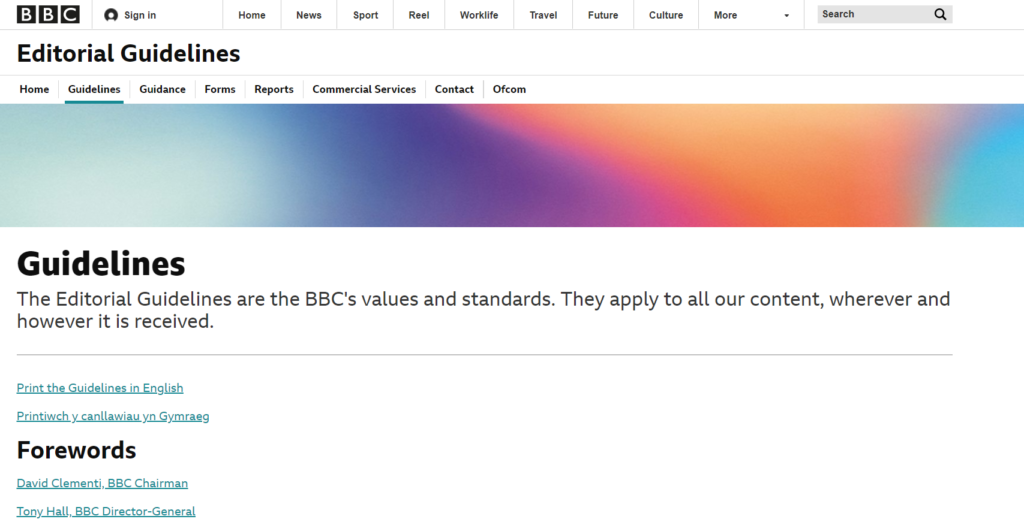
To see an example, you can access the BBC editorial guidelines here.
Compared to policies (which are oriented to the long term), editorial guidelines are prone to more frequent change, as they need to adapt to environmental influences. For instance, they may need to adapt to a guide about voice and tone on different social media platforms.
Procedures and processes
Procedures give clear guidance about the ways a process is being fulfilled, as well as the individuals who are fulfilling it. Procedures must be outlined according to policies, as they represent their direct implementation. Here are the main questions to ask: Which steps should you take to achieve a goal? Who is going to participate in every step?
Thus, the goal of a procedure is structuring the process. A process can be described as a series of tasks that turns inputs into outputs. For instance, “writing a blog article” is a process, but it requires procedures (such as who is writing the article, who will correct it, and when it needs to be finished).
Quick summary: policies, standards, guidelines, procedures, and processes
In summary, policies outline the broad direction and general goals of the content function, while standards help make them measurable. Editorial guidelines provide directional guides that are in line with the policy. Procedures give a clear step-by-step instruction for fulfilling a certain process. During the next section, we’re going to delve into a little more detail and explain how to set up procedures and processes.
Setting up procedures and processes for different content
Now that we’ve established clear roles and responsibilities and outlined our content policies, standards, and guidelines, we need to find a way to structure the content workflow.
To better understand procedures and processes, we must take a step back and look at the broader picture of the content workflow. This process entails many steps, and procedures need to be outlined and implemented for each step.
1. Planning stage
The first step of the content workflow is the planning stage. Planning involves defining the scope and related objectives of the deliverables. These objectives vary, depending on the project. Typical deliverables include blog articles, webpages, and videos. After the deliverables have been outlined, you need to formulate realistic milestones and due dates and account for possible bottlenecks and problems.
2. Creation stage
In this stage, you create the content according to the milestones agreed on in the first step. It is crucial that you outline as many details as possible in the planning stage. Otherwise, the creation stage might delay the milestones and targets. A robust content automation tool can streamline many tasks in this stage of the process.
3. Review stage
Depending on how the planning stage is outlined, a review can take place at multiple milestones or at the end of the creation stage. Among other things, this stage depends on the scale of the project. The larger a project, the more milestones you need review in between.
In order to avoid bottlenecks or email silos, we highly recommend making use of content review software (such as Filestage). Otherwise, you might lose days or even weeks, due to delayed responses.

Content review tools like Filestage allow your team and stakeholders to share, comment on, and approve content with each other. Instead of long feedback rounds via email, these tools clearly structure approval processes. So all stakeholders get involved.
4. Approval stage
If content needs to be changed, part of the work goes back to the creation stage. The approval should be documented, in order to create accountability. It is troublesome to save project-related emails from multiple stakeholders. Instead, it makes more sense to use content review software in this stage, just as you did in the review stage. Filestage and other content review tools allow stakeholders to approve your content and automatically document these approvals.
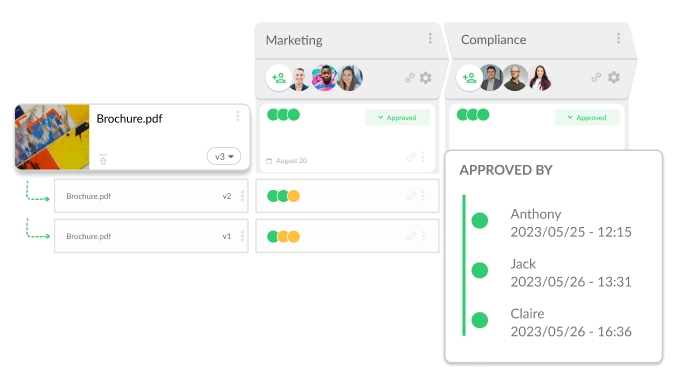
5. Publishing stage
The last stage involves publishing the content at the desired outlets. This process might include your company webpage or corporate blog.
6. Distribution stage
The publication process can be further refined into distribution, which might even be regarded as a separate stage (depending on the scope of the project). Distribution aims at making the content available to as many people as possible by sharing it via different channels (such social media and email).
Start documentation to ensure compliance
If you try to withdraw and change non-compliant content that has already been published, it could add unnecessary work, and it might even threaten the entire project.
Hence, defining supporting documents is of critical importance, in order to make the content workflow as smooth as possible and avoid any marketing compliance issues.
A good workflow requires clear roles and responsibilities. It also requires stakeholders, who act according to their scope of work, guidelines, and standards.
You might ask yourself whether these seemingly rigid rules are necessary. Would a more informal approach be a better fit for smaller companies?
As a rule of thumb, the bigger and more complex the organization and the more stakeholders are involved, the more rigid and structured the approach needs to be.
Policies
To recapitulate, policies are the most general yet most important part of the process. They form the foundation of the content governance model. They are the groundwork for further implementation.
So if you don’t comply at this point, it will lead to more critical mistakes and inconsistencies, compared to non-compliance during the usage of guidelines.
For instance, companies formulate non-disclosure policies that prohibit workers from leaking information about new product launches.
If employees don’t follow this policy, the whole company could be at risk. So policies need to be upheld and strictly enforced.
Standards
Standards further define what is acceptable and what isn’t—through clear boundaries and parameters. Even though non-compliance may not result in disastrous outcomes, they should still be clearly communicated to the stakeholders, as they act as supporting pillars of the policies.
The documentation of standards should be clear and easily accessible to all stakeholders. If they are overly complicated or aren’t readily available, they might be neglected.
While the strategic function involves approving certain standards, the operational function requires knowing them inside out, in order to adhere to the quality assurance role on a daily basis.
Guidelines
Guidelines are more difficult to formulate, as they cannot be measured with the same precision as standards. Therefore, you must keep guidelines narrow and succinct, in order to prevent divergence as much as possible.
You only need to provide examples if you need to clarify ambiguity. If the guidebook is long, we advise adding a summary. Examples of guidelines include messaging and tone. They can be further subdivided into messaging and tone across different social media channels.
Mailchimp made its content style guide public. It provides a great example of well-documented guidelines.

Procedures and processes
We advise companies to further formulate their procedures and processes and create visual workflows. This tactic not only provides a bird’s eye view on day-to-day tasks, but also offers a good opportunity to further streamline processes as needed.
At Filestage, we use Google Sites to document all of our internal processes and share process guides about topics like content creation and distribution.
Therefore, it isn’t easy to document regulations, but it is necessary to establish a common brand image. And it is important to make the supporting documents as precise as possible and regularly update all stakeholders, in case you make changes.
Content governance software, tools, and methods
As previously mentioned, the usage of suitable software can facilitate the entire process, and it’s essential for parts of the content workflow. In the following section, we introduce the most commonly used software and tools that every content team should use.
Content governance software
Learn more about the software you need, in order to support your content governance workflows. We’ve compiled a list of suitable software categories…
Content management systems
A content management system (CMS) is used to create and publish digital content (mostly on your website and blog). Typically, a CMS consists of two layers: an intuitive front-end interface that the user can see and a backend that allows the content team to create, edit, and publish content. WordPress is a famous example of a complete CMS.
Content review and approval software
Content review and approval software helps facilitate and document the most crucial parts of the content workflow, in order to get rid of possible bottlenecks. The review and approval stages offer the biggest potential for bottlenecks, as they involve a lot of stakeholders from multiple departments.
Therefore, good content review software needs to keep all communication and documentation in one place. As a dedicated content review software, Filestage provides both a platform for the entire workflow and offers specialized solutions for different industries.
Examples of this software include the Medical Legal Review (MLR) for the pharma industry and a solution for streamlining the creation of scientific articles for universities and research teams.
Supercharge your content reviews
Share, review, and approve all your content in one place with Filestage.
Digital asset management software
The increasing demand for content has led to a huge pile of data assets, such as images, videos, photos, documents, and other media. These assets need to be organized and shared within an organization and across third parties. Digital asset management software stores all files in one place and allows users to upload, store, backup, edit, and share data assets.
Project management software
Attentive readers should have noticed that content governance involves careful planning and organizing. Efficient project management software should help team members efficiently manage their tasks within their given deadlines. Filestage facilitates and streamlines the workflow within a team by simplifying the content review and approval process.
Communication tools
Communication drives a project forward. So it’s important to create an atmosphere of open discourse. If team members aren’t located in the same office, it’s essential to have good communication tools in place. Communication tools can be of general nature, such as instant messaging software. Or they can improve communication in specific areas or domains, such as content review software.
Internal knowledge base software
As stated earlier, content governance results in consistent messaging across all points of contact with the customer. Internal knowledge base software provides the foundation by containing valuable information about a company, product, or customer. Furthermore, an internal knowledge base makes marketing materials (such as branding templates) readily available in an organization.
Content governance tools and methods
To go even further into details, dedicated tools and methods support specific parts of the content review process.
For instance, editorial calendars help keep workflows organized. Calendars help maintain the planning stage and provide a visual representation of the entire workflow. These calendars structure the workflow and break it down further into a daily, weekly, or monthly overview. This tool is especially useful for content managers, who have multiple tasks at hand and require further assistance to stay organized.
To add a few other examples, creative briefings save time and help formulate thorough, precise briefings for a wide range of applications. A workflow chart defines the roles and responsibilities of every team member involved and provides the entire work process with a better understanding.
Content governance templates that save you time
It’s time to put theory into practice! Fortunately, there’s no need to start from scratch. In the following section, we summarize useful templates that facilitate the first steps for creating a content governance model.
Content strategy template
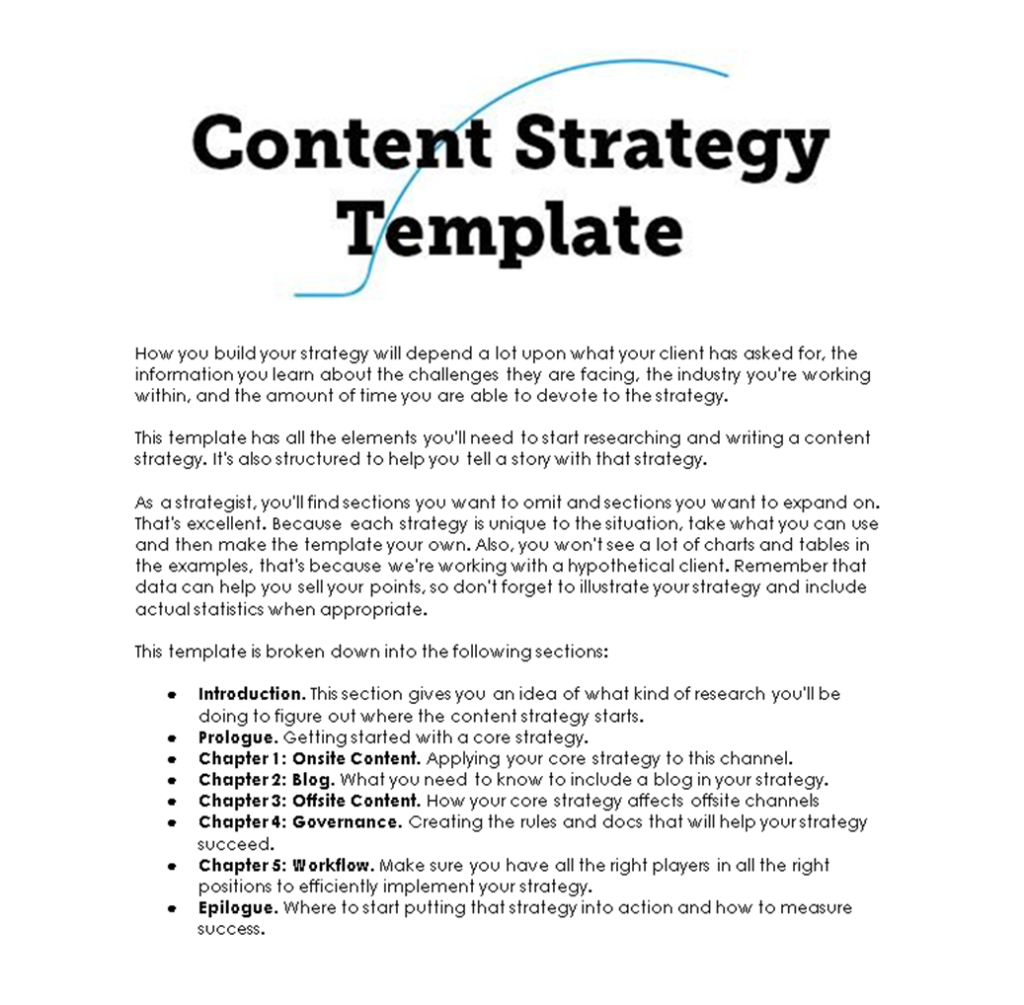
The first template outlines a straightforward approach to content governance in five chapters. From the get-go, this template places huge emphases on both defining company goals and targets and taking into account environmental factors that might influence the decision-making process.
In the following chapters, the authors offer advice about improving your company webpage and making use of external resources.
Chapters 4 and 5 go more into detail by giving valuable advice on establishing guidelines and improving workflows. And the introduction to content governance is an excellent starting point!
Editorial calendar template
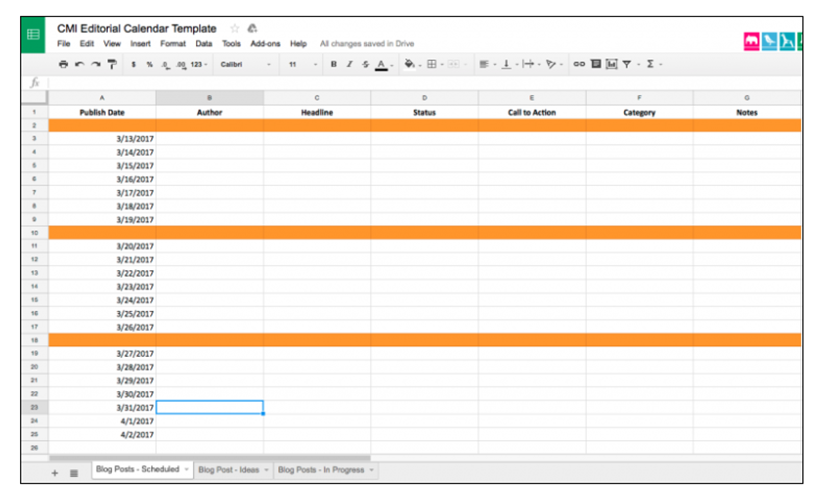
As already mentioned, an editorial calendar becomes more valuable as you add more tasks and people to the process. The editorial calendar blog provides both a great editorial template in Excel and a lot of valuable tips for making the most out of it.
After starting with a basic introduction, this guide and its editorial calendar template provide a detailed map for improving the table according to one’s own individual preferences.
In combination with the instructions, this template is perfect for beginners who haven’t previously used editorial calendars or need to refresh their knowledge of Excel.
Content briefing template
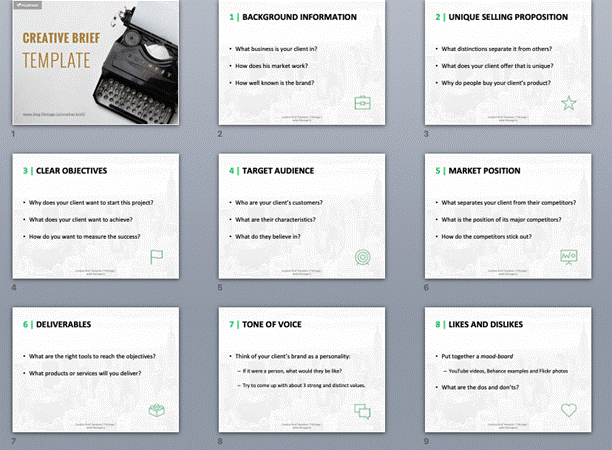
Everyone who’s worked with creative agencies knows the problems related to content briefing. Creative ideas are difficult to transmit and summarize. Therefore, our creative briefing template contains all the necessary information that a creative agency or other stakeholders need to create a convincing story.
Among other information, this template provides information about creating a company background, a target market, a tone of voice, and the preferences of the decision-makers. Everything is summarized and ready for you to fill out.
With all the information provided, creating a creative brief is an art in itself. This template saves valuable time and contains all the necessary information.
Editorial guidelines template

In this article, Kapost briefly mentions the problems you’ll encounter when creating guidelines. They don’t have measurable boundaries like standards do. In order to prevent starting from scratch, the editorial style template offers a perfect first touchpoint for getting one’s own editorial style guide (according to individual needs and preferences).
In addition to the article containing a great template, the website contains a lot of valuable information about avoiding pitfalls and keeping the editorial style guide succinct and clear. Then both company insiders and outsiders can quickly understand the main outline.
Content inventory audit worksheet template
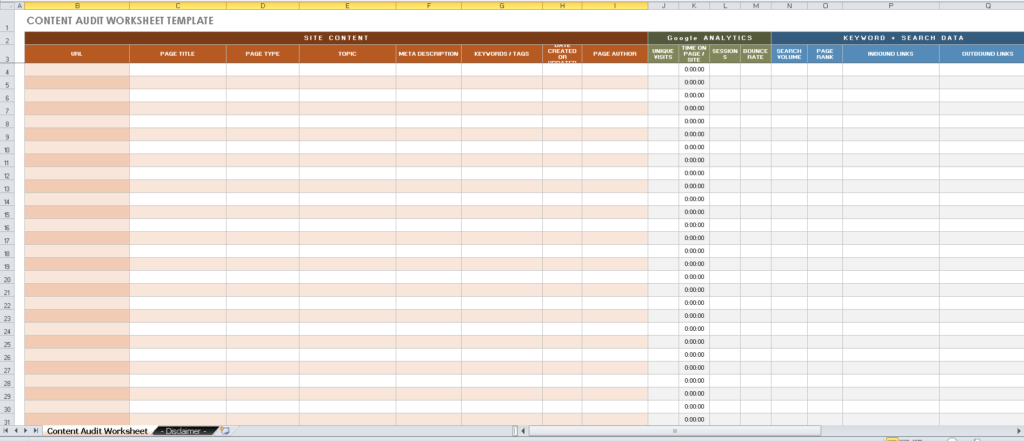
One problem with creating multiple projects involves knowing how to assemble all necessary information in one single file and keep track of all campaign outcomes.
This template can be used after the distribution process. It lists the URLs of multiple webpages, as well as SEO keywords and the crucial statistics of Google Analytics.
Since you can compare distribution tactics of different URLs to each other, the content inventory audit worksheet template facilitates the analysis of specific campaigns and enables an easy comparison. In addition to providing immediate results, this template can help you track SEO strategies in the long term.
Conclusion
Profound content governance needs dedicated roles, new team structures that extends between different functions, and a workflow that is agreed upon by all participants. This workflow also needs to be supported by policies, standards, and guidelines and facilitated via the help of dedicated software.
If you’d like to see how Filestage can help you build and maintain strong content governance, make sure to start a free trial.

